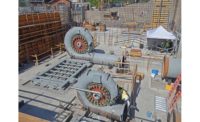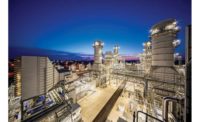ENR Midwest’s 2019 Best Projects
Excellence In Safety: Iowa Energy Plant Catalytic Reduction Has Stellar Record

Ottumwa Generating Station Selective Catalytic Reduction
PHOTOS COURTESY ALBERICI-STANLEY JV

Ottumwa Generating Station Selective Catalytic Reduction


Ottumwa Generating Station Selective Catalytic Reduction
Ottumwa, Iowa
Award of Merit, Energy/Industrial
Owner: Alliant Energy
General Contractor: Alberici Constructors
Lead Design Firm/Structural/MEP/Civil Engineer: Stanley Consultants
SCR Technology Provider: Riley Power
The installation of a selective catalytic reduction system at the Ottumwa Generation Station, a joint venture of Alberici Constructors and Stanley Consultants, not only delivered significant improvements to the 725-MW plant, it also achieved a remarkable record of safety and productivity.
The $100-million-plus project is designed to reduce nitrogen oxide emissions by at least 83%. The new system was installed above the plant’s existing electrostatic precipitators. The team devised creative rigging solutions to install steel within a confined project footprint. The installation is roughly 240 ft tall and includes 3,400 tons of structural steel, 40,000 sq ft of grating with handrails and 156,000 tension control bolts, which support 5,000 tons of operating equipment and ductwork along with 1,500 tons of live load.
The project was completed on time and on budget with no owner non-conformance reports and no contractor-initiated change orders. Dieter Bareiss, project manager with Alberici Constructors, credits the project’s success to the team’s collaborative approach. Roughly 75% of the Alberici Constructors and Stanley Consultants team members on the project have worked together on previous projects. “We’ve been doing projects together for years and that goes a long way toward having a successful [engineer-procure-construct] team.”
The project team also delivered an exceptional safety record, performing more than 600,000 work hours with no recordable injuries. Bareiss says the project’s safety program was rooted in a strong partnership between Alliant Energy, craft leadership and the EPC team. Representatives from all three partners held a “safety summit” before the start of the job to develop best practices.
A site safety steering committee met biweekly to focus on safety measures and share lessons learned. “Our head of safety and the owner’s corporate safety director spoke almost daily,” Bareiss says.
The EPC team leaders coordinated with the plant team to standardize safety guidelines among plant operations and the construction team.
Rather than institute the company’s standard stretch program to prepare workers for physical labor, Bareiss decided to give it an update. “We thought that was getting stale, so our safety manager on site had a certified physical therapist come on site to give us new ideas,” he says.
Dubbed the “industrial athlete” approach, its mobility readiness program involved full body exercises that varied depending on the trade and daily exposure levels. Workers would stretch in the morning as well as after lunch. Bareiss says the EPC team’s safety manager used stretching sessions as an opportunity to evaluate workers and to identify those who might be right or wrong for specific situations.
The EPC team stationed a nurse on site, which Bareiss says was important to provide treatment quickly due to the site’s remote location. Bareiss says the nurse’s main function was to provide a comfort station, especially on hot days. “If someone was overcome by heat, they could go in and get a cold compress and not have to make an emergency room visit,” he says.
The team also hosted an “ugly boot” competition to help highlight the importance of good tread on footwear. “We had tough conditions with the snow, and this was a way to get everyone to check their boots,” he says.
Back to "35 Best Projects Showcase Midwest Design, Construction Innovation"






